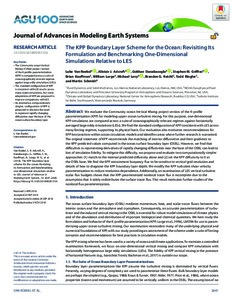| dc.contributor.author | Van Roekel, Luke | |
| dc.contributor.author | Adcroft, Alistair J. | |
| dc.contributor.author | Danabasoglu, Gokhan | |
| dc.contributor.author | Griffies, Stephen M. | |
| dc.contributor.author | Kauffman, Brian | |
| dc.contributor.author | Large, William | |
| dc.contributor.author | Levy, Michael | |
| dc.contributor.author | Reichl, Brandon G. | |
| dc.contributor.author | Ringler, Todd | |
| dc.contributor.author | Schmidt, Martin | |
| dc.date.accessioned | 2019-02-28T14:34:39Z | |
| dc.date.available | 2019-02-28T14:34:39Z | |
| dc.date.issued | 2018 | |
| dc.identifier.citation | Van Roekel, L. P., Adcroft, A., Danabasoglu, G., Griffies, S. M., Kauffman, B., Large, W. G., et al. (2018). The KPP boundary layer
scheme for the ocean: revisiting its formulation and benchmarking one-dimensional simulations relative to LES. Journal of Advances in Modeling Earth Systems, 10, pp.2647–2685. DOI: 10.1029/2018MS001336 | en_US |
| dc.identifier.uri | http://hdl.handle.net/11329/864 | |
| dc.identifier.uri | http://dx.doi.org/10.25607/OBP-411 | |
| dc.description.abstract | We evaluate the Community ocean Vertical Mixing project version of the K-profile
parameterization (KPP) for modeling upper ocean turbulent mixing. For this purpose, one-dimensional
KPP simulations are compared across a suite of oceanographically relevant regimes against horizontally
averaged large eddy simulations (LESs).We find the standard configuration of KPP consistent with LES across
many forcing regimes, supporting its physical basis. Our evaluation also motivates recommendations for
KPP best practices within ocean circulation models and identifies areas where further research is warranted.
The original treatment of KPP recommends the matching of interior diffusivities and their gradients to
the KPP-predicted values computed in the ocean surface boundary layer (OSBL). However, we find that
difficulties in representing derivatives of rapidly changing diffusivities near the base of the OSBL can lead to
loss of simulation fidelity. To mitigate this difficulty, we propose and evaluate two computationally simpler
approaches: (1) match to the internal predicted diffusivity alone and (2) set the KPP diffusivity to 0 at
the OSBL base. We find the KPP entrainment buoyancy flux to be sensitive to vertical grid resolution and
details of how to diagnose the KPP boundary layer depth. We modify the KPP turbulent shear velocity
parameterization to reduce resolution dependence. Additionally, an examination of LES vertical turbulent
scalar flux budgets shows that the KPP-parameterized nonlocal tracer flux is incomplete due to the
assumption that it solely redistributes the surface tracer flux. This result motivates further studies of the
nonlocal flux parameterization. | en_US |
| dc.language.iso | en | en_US |
| dc.rights | Attribution-NonCommercial-NoDerivs 4,0 | * |
| dc.rights.uri | http://creativecommons.org/licenses/by-nc-nd/4.0/ | * |
| dc.subject.other | Surface boundary layer | en_US |
| dc.subject.other | Turbulence | en_US |
| dc.subject.other | Vertical mixing | en_US |
| dc.title | The KPP Boundary Layer Scheme for the Ocean: revisiting its formulation and benchmarking one-dimensional simulations relative to LES. | en_US |
| dc.type | Journal Contribution | en_US |
| dc.description.refereed | Refereed | en_US |
| dc.format.pagerange | pp.2647–2685 | en_US |
| dc.identifier.doi | 10.1029/2018MS001336 | |
| dc.subject.parameterDiscipline | Parameter Discipline::Physical oceanography | en_US |
| dc.bibliographicCitation.title | Journal of Advances in Modeling Earth Systems | en_US |
| dc.bibliographicCitation.volume | 10 | en_US |
| dc.description.sdg | 14.A | en_US |
| dc.description.bptype | Standard Operating Procedure | en_US |
| dc.description.bptype | Guide | en_US |
| obps.contact.contactemail | lvanroekel@lanl.gov | |
| obps.resourceurl.publisher | https://agupubs.onlinelibrary.wiley.com/doi/pdf/10.1029/2018MS001336 | en_US |
 Repository of community practices in Ocean Research, Applications and Data/Information Management
Repository of community practices in Ocean Research, Applications and Data/Information Management

